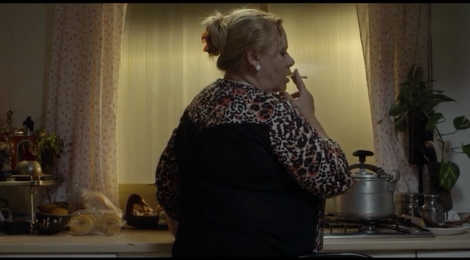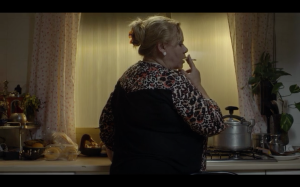
Letter from Madrid: Carmina y amén and Stella Cadente
Mediático is delighted to present an entry by contributing editor Paul Julian Smith, Distinguished Professor, PhD Program in Hispanic and Luso-Brazilian Languages and Literatures at the Graduate Center, City University of New York.
Opposites attract and extremes meet. Two current releases playing Madrid theatres prove the truth of these cliches. In the first a coarse comedy by a TV-trained director shows an affinity for the paradoxes of art cinema; and in the second a period picture from the midwife of Catalan auteur movies reveals an unexpected interest in visual pleasure and pop culture. Both features, incidentally, also display different facets of the exhibition scene in the capital.
Carmina y amén is the sequel to Carmina o revienta (2012), the first film directed by Paco León, famous for his performance over nine years as the hapless Luisma in Telecinco‘s Aída, Spain’s most popular and longest lasting sitcom. Repeating Aída‘s working class setting and gross-out humour, the Carmina films transfer the picaresque plot and cast to León’s native Seville. They are a family affair. Paco’s non-professional mother Carmina (most characters keep their real names), fat, ugly, and very determined, seems at first a grotesque figure straight out of the Spanish tradition of esperpento. The first film turns around a missing ham and Carmina’s successful attempt to fool the insurance company over the theft. The second feature is more sober. It begins as Carmina shuffles into the kitchen, smoking her eternal cigarette, and nagging her slobbish husband about his new medication. When he fails to respond, she goes into the living room where he has suddenly died (off screen) in his favourite armchair. The McGuffin of the sequel, then, will be that the family must conceal the dead body for two days in order to receive the extra paycheck due the father, if he were still alive.
Using a minimalist aesthetic appropriate to its budget (the first film is said to have cost just $40K), the sequel proceeds via pseudo-reality footage of dialogues or monologues at the kitchen table. Carmina addresses the corpse while coping with a feisty pet cockatoo (the family goat of Carmina o revienta sadly fails to make a return appearance). One neighbour drops in with her developmentally disabled son (‘El niño’ is in his 30s) and shyly recounts her erotic encounter with a Catalan masseuse; another discusses her career at a sex phone line where she specialized in stories of flapping vaginas. Exteriors show Carmina’s brutal son evicting squatters from the building where her daughter (played by Paco’s professional actress sister María) hopes to set up what her mother calls a ‘hairdresser’s’ and she insists, in a running joke, is a ‘beauty parlour’ (‘centro de estética’). In the most farcical scene Carmina’s blouse is blown off when she takes a perilous trip on her son’s motorbike. The fact that the film was playing at perhaps the most alienating shopping mall multiplex in Madrid, the Cinesa Méndez Álvaro, would seem to confirm that this is the lowest common denominator of popular cinema.
However, things prove more complex than this. Carmina o revienta had been a pioneer in multi-platform release, simultaneously available (in Spain at least) online, on DVD, and in theatres. Carmina y amén cannily exploits the internet (you can upload a version of yourself as the heroine on the poster, haloed by a funeral wreath) and the director’s closeness to his audience (he scheduled personal appearances to the five cities that showed the most social media interest in the film). On the official website León notes three paradoxes he is exploring in his quest for what he calls a new cinematic language: the co-direction of professional and non-professional actors, the exploration of the limits of scripted and improvised dialogue, and the fusion of comedy and drama. Although Carmina y amén won the prize at the Málaga film festival for best script, it is perhaps this last question of genre which is most important here, as León’s film constantly shifts in tone on a dime. Thus it is, from the opening sequence, haunted by death, in spite of its transparent celebration of a working class community that, beyond the limits of traditional family, effortlessly embraces disability and queerness. That masseuse-satisfied neighbour hints darkly that she would rather kill her disabled son than have him survive her, alone and vulnerable. María León, surely the best young actress in Spain today and wasted in conventional Civil War dramas like Benito Zambrano’s La voz dormida (2011), has a tearful tour de force some ten minutes long taking her leave of her mother after she discovers the father’s death (later Carmina will tell her with typical acerbity not to ‘overact’). And a late funeral scene is beautifully shot in high definition slow motion, with dust and petals scattering in the wind. Moreover a final twist reveals that this is truly the end: there can be no further sequels.
Prejudice against television in Spain and a confusion of naturalism with simplicity no doubt mean that León’s evident bid for auteurism will go unrecognized in his own country. Yet, as Variety wrote, ‘Low budget pics come with high ambitions’. It is an article that includes reference to both Carmina and another new release, Lluís Miñarro’s first fiction feature Stella cadente. Unlike Carmina, Stella comes trailing cultural distinction. Miñarro is the storied producer of the most austere and demanding Catalan art cinema, including that of Albert Serra (he also produced Apichatpong Weerasethakul). His topic here is equally unpromising: the brief reign of a forgotten monarch, Amadeo, who came unhappily to the Spanish throne in 1870. I saw Stella, previously shown at that most rigorous of art movie festivals Rotterdam, with an audience of the proverbial ‘cuatro gatos’ at the tiny, hushed Pequeño Cine Estudio, a world away from Carmina‘s noisy multiplex.
If León seeks a new cinematic language allied with reality television, Miñarro recreates an old cinematic language, the period pieces of the 1970s, the decade when, he said in interview, ‘we were so happy’. As Alex Brendemühl as the king paces the palace that soon becomes his prison, echoes of Visconti’s Ludwig are hard to ignore. And Miñarro has an antiquarian interest in recreating paintings and making arch literary references in his mise-en-scene. Cooks preparing the sumptuous royal meals (the king, however, will eat only fruit) echo Velásquez, while a jewel-studded tortoise cites that forgotten classic of fin de siecle decadence Huysmans’ À Rebours. Stella becomes, then, a homage to the generic pan-European art movie: the film’s title and its on-screen titles (the location is given simply as ‘Spagna’) are in Italian, as are the joking references to the film’s ‘acts’ (‘Primo tempo’, ‘Secondo tempo’). The many gorgeous frocks sported by Amadeo’s unhappy consort recall the sumptuous wardrobes curated by Visconti once more. Surely this is the first time that each item of jewellery in a film should get its own credit?
Far from the studied austerity and pleasureless provocation of his prodigy Serra, then, Miñarro glories in the sensual pleasure of old-school auteurism. Not for nothing does the director call his film a ‘divertimento’ that is devoted to ‘gozo’. And, unlike his Italian models, he can now make his queer allegiance much more explicit. Thus, the King of Spain’s palace (the location is actually in Italy), festooned with fruit and flowers, is also staffed by beautiful boys. In one surprising sequence, strangely unmentioned by Spanish critics, the king’s valet (played by out gay actor Lorenzo Balducci) is shown fucking a melon (it is later fed to the unsuspecting monarch). And one of the paintings recreated in Stella is Corot’s L’Origine du monde, a close up of female genitalia, here replayed in the masculine mode by the generous Balducci once more. More even than the often Rabelaisian Carmina, which is in fact melancholic in its insistence on mortality, Stella is unexpectedly devoted to sensual delight and sheer fun. Like Sofia Coppola’s Marie Antoinette, Miñarro’s ironic biopic plays with anachronism: those jewels (sensuously licked by lackeys) are not in period; the soundtrack uses tacky French songs of the 60s like Alain Barrière’s Eurovision ballad ‘Elle était si jolie’. The credits even show the cast mugging and dancing for the camera as if they were in a sitcom.
Finally, what both films (the serious comedy, the faux art movie) have in common is, in another surprise, politics. Carmina shows throughout the cruelty of the crisis in Spain, with a matriarch who will stop at nothing to provide for a family on the brink of financial disaster. Stella could not have anticipated that its portrait of a would-be modernizing monarch (Amadeo declares himself ‘the first Republican king’) would be released at exactly the same time as another new and handsome head of state would come to the throne in a (once more) deeply troubled nation. Equally pleasurable, thoughtful, and original, this odd couple of films from two unlikely auteurs point the way to new, linked futures for the cinema of the Spanish state.







